Page No 9: Ex. 1A
Question 1:
Is zero a rational number? Justify.
Answer:
Yes, 0 is a rational number.
0 can be expressed in the form of the fraction , where and q can be any integer except 0.
Question 2:
Represent each of the following rational number line:
(i)
(ii)
(iii)
(iv) 1.3
(v) – 2.4
Answer:
(i)

(ii)

(iii)

(iv) 1.3

(v) – 2.4

Question 3:
Find a rational number between
(i)
(ii) 1.3 and 1.4
(iii)
(iv)
(v)
Answer:
(i)
Let:
x = and y =
Rational number lying between x and y:
=
(ii) 1.3 and 1.4
Let:
x = 1.3 and y = 1.4
Rational number lying between x and y:
=
(iii)
Let:
x = 1 and y =
Rational number lying between x and y:
=
(iv)
Let:
x = and y =
Rational number lying between x and y:
=
(v)
A rational number lying between will be
Question 4:
Find three rational numbers lying between . How many rational numbers can be determined between these two numbers?
Answer:
n = 3
Rational numbers between will be
There are infinitely many rational numbers between two given rational numbers.
Question 5:
Find four rational numbers between .
Answer:
n = 4
n + 1 = 4 + 1 = 5
Thus, rational numbers between are .
Question 6:
Find six rational numbers between 2 and 3.
Answer:
x = 2, y = 3 and n = 6
Thus, the required numbers are
Question 7:
Find five rational numbers between .
Answer:
n = 5
n + 1 = 6
Thus, rational numbers between will be
Question 8:
Insert 16 rational numbers between 2.1 and 2.2.
Answer:
Let:
x = 2.1, y = 2.2 and n = 16
We know:
d = = 0.005 (approx.)
So, 16 rational numbers between 2.1 and 2.2 are:
(x + d), (x + 2d), ...(x + 16d)
= [2.1 + 0.005], [2.1 + 2(0.005)],...[2.1 + 16(0.005)]
= 2.105, 2.11, 2.115, 2.12, 2.125, 2.13, 2.135, 2.14, 2.145, 2.15, 2.155, 2.16, 2.165, 2.17, 2.175 and 2.18
Question 9:
State whether the following statements are true or false. Give reasons for your answer.
(i) Every natural number is a whole number.
(ii) Every whole number is a natural number.
(iii) Every integer is a whole number.
(iv) Every integer is a rational number.
(v) Every rational number is an integer.
(vi) Every rational number is a whole number.
Answer:
(i) Every natural number is a whole number.
True, since natural numbers are counting numbers i.e N = 1, 2,...
Whole numbers are natural numbers together with 0. i.e W = 0, 1, 2,...
So, every natural number is a whole number
(ii) Every whole number is a natural number.
False, as whole numbers contain natural numbers and 0 whereas natural numbers only contain the counting numbers except 0.
(iii) Every integer is a whole number.
False, whole numbers are natural numbers together with a zero whereas integers include negative numbers also.
(iv) Every integer is a rational number.
True, as rational numbers are of the form . All integers can be represented in the form .
(v) Every rational number is an integer.
False, as rational numbers are of the form . Integers are negative and positive numbers which are not in form.
For example, is a rational number but not an integer.
(vi) Every rational number is a whole number.
False, as rational numbers are of the form . Whole numbers are natural numbers together with a zero.
For example, is a rational number but not a whole number.
Page No 18: Ex. 1B
Question 1:
Write actual division, find which of the following rational numbers are terminating decimals.
(i)
(ii)
(iii)
(iv)
(v)
Answer:
(i)
Denominator of is 80.
And,
80 = 245
Therefore, 80 has no other factors than 2 and 5.
Thus, is a terminating decimal.
(ii)
Denominator of is 24.
And,
24 = 233
So, 24 has a prime factor 3, which is other than 2 and 5.
Thus, is not a terminating decimal.
(iii)
Denominator of is 12.
And,
12 = 223
So, 12 has a prime factor 3, which is other than 2 and 5.
Thus, is not a terminating decimal.
(iv)
Denominator of is 375.
So, the prime factors of 375 are 5 and 3.
Thus, is not a terminating decimal.
(v)
Denominator of is 125.
And,
125 = 53
Therefore, 125 has no other factors than 2 and 5.
Thus, is a terminating decimal.
Question 2:
Write each of the following in decimal form and say what kind of decimal expansion each has.
(i)
(ii)
(iii)
(iv)
(v)
(vi)
(vii)
(viii)
Answer:
(i) = 0.625
By actual division, we have:
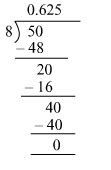
It is a terminating decimal expansion.
(ii)
= 0.28
By actual division, we have:
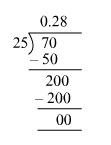
It is a terminating decimal expansion.
(iii) =
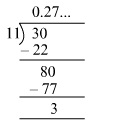
It is a non-terminating recurring decimal.
(iv) =
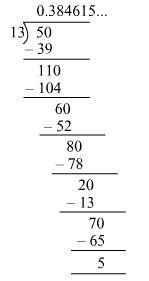
It is a non-terminating recurring decimal.
(v)
= 
By actual division, we have:
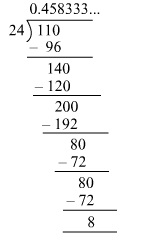
It is nonterminating recurring decimal expansion.
(vi)
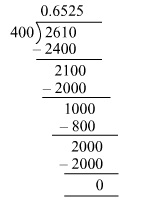
It is a terminating decimal expansion.
(vii)
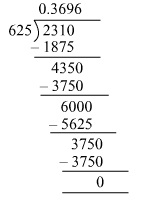
It is a terminating decimal expansion.
(viii)
2 = = 
By actual division, we have:
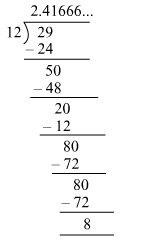
It is non-terminating decimal expansion.
Question 3:
Express each of the following decimals in the form , where p, q are integers and q ≠ 0.
(i)
(ii)
(iii)
(iv)
(v)
(vi)
(vii)
(viii)
(ix)
(x)
Answer:
(i)
Let x = 0.222... .....(i)
Only one digit is repeated so, we multiply x by 10.
10x = 2.222... .....(ii)
Subtracting (i) from (ii) we get
(ii)
Let x = 0.5353... .....(i)
Two digits are repeated so, we multiply x by 100.
100x = 53.5353... .....(ii)
Subtracting (i) from (ii) we get
(iii)
Let x = 2.9393... .....(i)
Two digits are repeated so, we multiply x by 100.
100x = 293.9393... .....(ii)
Subtracting (i) from (ii) we get
(iv)
Let x = 18.4848... .....(i)
Two digits are repeated so, we multiply x by 100.
100x = 1848.4848... .....(ii)
Subtracting (i) from (ii) we get
(v)
Let x = 0.235235... .....(i)
Three digits are repeated so, we multiply x by 1000.
1000x = 235.235235... .....(ii)
Subtracting (i) from (ii) we get
(vi)
Let x = 0.003232... .....(i)
we multiply x by 100.
100x = 0.3232... .....(ii)
Again multiplying by 100 as there are 2 repeating numbers after decimals we get
10000x = 32.3232... .....(iii)
Subtracting (ii) from (iii) we get
(vii)
Let x = 1.32323... .....(i)
we multiply x by 10.
10x = 13.2323... .....(ii)
Again multiplying by 100 as there are 2 repeating numbers after decimals we get
1000x = 1323.2323... .....(iii)
Subtracting (ii) from (iii) we get
(viii)
Let x = 0.3178178... .....(i)
we multiply x by 10.
10x = 3.178178... .....(ii)
Again multiplying by 1000 as there are 3 repeating numbers after decimals we get
10000x = 3178.178178... .....(iii)
Subtracting (ii) from (iii) we get
(ix)
Let x = 32.123535... .....(i)
we multiply x by 100.
100x = 3212.3535... .....(ii)
Again multiplying by 100 as there are 2 repeating numbers after decimals we get
10000x = 321235.35... .....(iii)
Subtracting (ii) from (iii) we get
(x)
Let x = 0.40777... .....(i)
we multiply x by 100.
100x = 40.7777... .....(ii)
Again multiplying by 10 as there is 1 repeating number after decimals we get
1000x = 407.777... .....(iii)
Subtracting (ii) from (iii) we get
Question 4:
Express as a fraction in simplest form.
Answer:
Given:
Let
First we take x and convert it into
100x = 236.3636... ...(iii)
Subtracting (i) from (iii) we get
Similarly, multiply y with 100 as there are 2 decimal places which are repeating themselves.
...(iv)
Subtracting (ii) from (iv) we get
Adding x and y we get
=
Question 5:
Express in the form of .
Answer:
x = 0.3838... ...(i)
Multiply with 100 as there are 2 repeating digits after decimals
100x = 38.3838... ...(ii)
Subtracting (i) from (ii) we get
99x = 38
Similarly, we take
y = 1.2727... ...(iii)
Multiply y with 100 as there are 2 repeating digits after decimal.
100y = 127.2727... ...(iv)
Subtract (iii) from (iv) we get
99y = 126
Page No 23: Ex. 1C
Question 1:
What are irrationl numbers? How do they differ from rational numbers? Give examples.
Answer:
A number that can neither be expressed as a terminating decimal nor be expressed as a repeating decimal is called an irrational number. A rational number, on the other hand, is always a terminating decimal, and if not, it is a repeating decimal.
Examples of irrational numbers:
0.101001000...
0.232332333...
Question 2:
Classify the following numbers as rational or irrational. give reasons to support your answer.
(i)
(ii)
(iii)
(iv)
(v)
(vi) 4.1276
(vii)
(viii) 1.232332333...
(ix) 3.040040004....
(x) 2.356565656...
(xi) 6.834834...
Answer:
(i)
It is an irrational number.
(ii) = 19
So, it is rational.
(iii)
(iv) = 1.2
So, it is rational.
(v)
It is an irrational number
(vi) 4.1276
It is a terminating decimal. Hence, it is rational.
(vii)
(viii) 1.232332333...
(xi) 6.834834... is a rational number because it is repeating.
Question 3:
Let x be a rational number and y be an irrational number. Is x + y necessarily an irrational number? Give a example in support of your answer.
Answer:
x be a rational number and y be an irrational number then x + y necessarily will be an irrational number.
Example: 5 is a rational number but is irrational.
So, 5 + will be an irrational number.
Question 4:
Let a be a rational number and b be an irrational number. Is ab necessarily an irrational number? Justify your answer with an example.
Answer:
a be a rational number and b be an irrational number then ab necessarily will be an irrational number.
Example: 6 is a rational number but is irrational. And 6 is also an irrational number.
Question 5:
Is the product of two irrationals always irrational? Justify your answer.
Answer:
Product of two irrational numbers is not always an irrational number.
Example: is irrational number. And is a rational number. But the product of another two irrational numbers is which is also an irrational numbers.
Question 6:
Give an example of two irrational numbers whose
(i) difference is an irrational number.
(ii) difference is a rational number.
(iii) sum is an irrational number.
(iv) sum is a rational number.
(v) product is an irrational number.
(vi) product is a rational number.
(vii) quotient is an irrational number.
(viii) quotient is a rational number.
Answer:
(i) 2 irrational numbers with difference an irrational number will be .
(ii) 2 irrational numbers with difference is a rational number will be
(iii) 2 irrational numbers with sum an irrational number
(iv) 2 irrational numbers with sum a rational number is
(v) 2 irrational numbers with product an irrational number will be
(vi) 2 irrational numbers with product a rational number will be
(vii) 2 irrational numbers with quotient an irrational number will be
(viii) 2 irrational numbers with quotient a rational number will be .
Question 7:
Examine whether the following numbers are rational or irrational.
(i)
(ii)
(iii)
(iv)
(v)
(vi)
Answer:
(i) Let us assume, to the contrary, that is rational.
Then, , where p and q are coprime and .
Since, p and q are are integers.
is rational.
So, is also rational.
But this contradicts the fact that is irrational.
This contradiction has arisen because of our incorrect assumption that is rational.
Hence, is irrational.
(ii) Let us assume, to the contrary, that is rational.
Then, , where p and q are coprime and .
Since, p and q are are integers.
is rational.
So, is also rational.
But this contradicts the fact that is irrational.
This contradiction has arisen because of our incorrect assumption that is rational.
Hence, is irrational.
(iii) As,
Hence, is rational.
(iv) As,
Hence, is rational.
(v) As,
Hence, is rational.
(vi) As,
Hence, is rational.
Question 8:
Insert a rational and an irrational number between 2 and 2.5.
Answer:
As, few rational numbers between 2 and 2.5 are: 2.1, 2.2, 2.3, 2.4, ...
And,
Since,
So, irrational number between 2 ans 2.5 are:
Hence, a rational and an irrational number can be 2.1 and , respectively.
Disclaimer: There are infinite rational and irrational numbers between any two rational numbers.
Question 9:
How many irrational numbers lie between ? Find any three irrational numbers lying between .
Answer:
There are infinite number of irrational numbers lying between .
As,
So, the three irrational numbers lying between are:
1.420420042000..., 1.505005000... and 1.616116111...
Question 10:
Find two rational and two irrational number between 0.5 and 0.55.
Answer:
The two rational numbers between 0.5 and 0.55 are: 0.51 and 0.52
The two irrational numbers between 0.5 and 0.55 are: 0.505005000... and 0.5101100111000...
Disclaimer: There are infinite number of rational and irrational numbers between 0.5 and 0.55.
Question 11:
Find three different irrational numbers between the rational numbers .
Answer:
So, the three different irrational numbers are: 0.72020020002..., 0.7515511555111... and 0.808008000...
Disclaimer: There are an infinite number of irrational numbers between two rational numbers.
Question 12:
Find two rational numbers of the form between the numbers 0.2121121112... and 0.2020020002... .
Answer:
The rational numbers between the numbers 0.2121121112... and 0.2020020002... are:
Disclaimer: There are an infinite number of rational numbers between two irrational numbers.
Question 13:
Find two irrational numbers between 0.16 and 0.17.
Answer:
The two irrational numbers between 0.16 and 0.17 are 0.161161116... and 0.1606006000...
Disclaimer: There are an infinite number of irrational numbers between two rational numbers.
Question 14:
State in each case, whether the given statement is true of false.
(i) The sum of two rational numbers is rational.
(ii) The sum of two irrational numbers is irrational.
(iii) The product of two rational numbers is rational.
(iv) The product of two irrational number is irrational.
(v) The sum of a rational number and an irrational number is irrational.
(vi) The product of a nonzero rational number and an irrational number is a rational number.
(vii) Every real number is rational.
(viii) Every real number is either rational or irrational.
(ix) is irrational andis rational.
Answer:
(i) True
(ii) False
Example:
(iii) True
(iv) False
(v) True
(vi) False
Example:
(vii) False
Real numbers can be divided into rational and irrational numbers.
(viii) True
(ix) True
Page No 27: Ex. 1D
Question 1:
Add:
(i)
(ii)
(iii)
Answer:
Question 2:
Multiply:
(i)
(ii)
(iii)
(iv)
(v)
(vi)
Answer:
Question 3:
Divide:
(i)
(ii)
(iii)
Answer:
Question 4:
Simplify
(i)
(ii)
(iii)
(iv)
(v)
(vi)
Answer:
(i)
(ii)
(iii)
(iv)
(v)
(vi)
Question 5:
Simplify .
Answer:
Question 6:
Examine whether the following numbers are rational or irrational:
(i)
(ii)
(iii)
(iv)
Answer:
(i)
Hence, is rational.
(ii)
Since, the sum and product of rational numbers and an irrational number is always an irrational.
is irrational.
Hence, is irrational.
(iii)
Hence, is rational.
(iv)
Since, the product of a rational number and an irrational number is always an irrational.
Hence, is rational.
Question 7:
On her birthday Reema distributed chocolates in an orphanage. The total number of chocolates she distributed is given by .
(i) Find the number of chocolates distributed by her.
(ii) Write the moral values depicted here by Reema.
Answer:
(i) As,
Hence, the number of chocolates distributed by Reema is 14.
(ii) The moral values depicted here by Reema is helpfulness and caring.
Disclaimer: The moral values may vary from person to person.
Question 8:
Simplify
(i)
(ii)
(iii)
Answer:
(i)
(ii)
(iii)
Page No 35: Ex. 1E
Question 1:
Represent on the number line.
Answer:

To represent on the number line, follow the following steps of construction:
(i) Mark points 0 and 2 as O and P, respectively.
(ii) At point A, draw AB OA such that AB = 1 units.
(iii) Join OB.
(iv) With O as centre and radius OB, draw an arc intersecting the number line at point P.
Thus, point represents on the number line.
Justification:
In right OAB,
Using Pythagoras theorem,
Question 2:
Locate on the number line.
Answer:
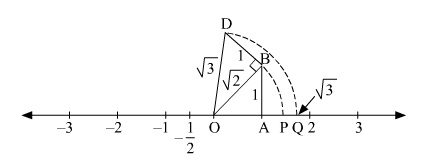
To represent on the number line, follow the following steps of construction:
(i) Mark points 0 and 1 as O and A, respectively.
(ii) At point A, draw AB OA such that AB = 1 units.
(iii) Join OB.
(iv) At point B, draw DB OA such that DB = 1 units.
(v) Join OD.
(vi) With O as centre and radius OD, draw an arc intersecting the number line at point Q.
Thus, point Q represents on the number line.
Justification:
In right OAB,
Using Pythagoras theorem,
Again, in right ODB,
Using Pythagoras theorem,
Question 3:
Locate on the number line.
Answer:

To represent on the number line, follow the following steps of construction:
(i) Mark points 0 and 3 as O and B, respectively.
(ii) At point A, draw AB OA such that AB = 1 units.
(iii) Join OA.
(iv) With O as centre and radius OA, draw an arc intersecting the number line at point P.
Thus, point P represents on the number line.
Justification:
In right OAB,
Using Pythagoras theorem,
Question 4:
Locate on the number line.
Answer:

To represent on the number line, follow the following steps of construction:
(i) Mark points 0 and 2 as O and B, respectively.
(ii) At point B, draw AB OA such that AB = 2 units.
(iii) Join OA.
(iv) With O as centre and radius OA, draw an arc intersecting the number line at point P.
Thus, point P represents on the number line.
Justification:
In right OAB,
Using Pythagoras theorem,
Question 5:
Represent geometrically on the number line.
Answer:
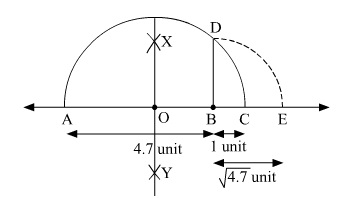
To represent on the number line, follow the following steps of construction:
(i) Mark two points A and B on a given line such that AB = 4.7 units.
(ii) From B, mark a point C on the same given line such that BC = 1 unit.
(iii) Find the mid point of AC and mark it as O.
(iv) With O as centre and radius OC, draw a semi-circle touching the given line at points A and C.
(v) At point B, draw a line perpendicular to AC intersecting the semi-circle at point D.
(vi) With B as centre and radius BD, draw an arc intersecting the given line at point E.
Thus, let us treat the given line as the number line, with B as 0, C as 1, and so on, then point E represents .
Justification:
Here, in semi-circle, radii OA = OC = OD =
And, OB = AB AO = 4.7 2.85 = 1.85 units
In a right angled triangle OBD,
Question 6:
Represent on the number line.
Answer:
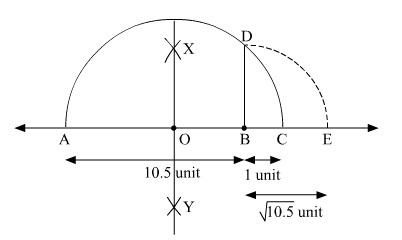
To represent on the number line, follow the following steps of construction:
(i) Mark two points A and B on a given line such that AB = 10.5 units.
(ii) From B, mark a point C on the same given line such that BC = 1 unit.
(iii) Find the mid point of AC and mark it as O.
(iv) With O as centre and radius OC, draw a semi-circle touching the given line at points A and C.
(v) At point B, draw a line perpendicular to AC intersecting the semi-circle at point D.
(vi) With B as centre and radius BD, draw an arc intersecting the given line at point E.
Thus, let us treat the given line as the number line, with B as 0, C as 1, and so on, then point E represents .
Justification:
Here, in semi-circle, radii OA = OC = OD =
And, OB = AB AO = 10.5 5.75 = 4.75 units
In a right angled triangle OBD,
Question 7:
Represent geometrically on the number line.
Answer:
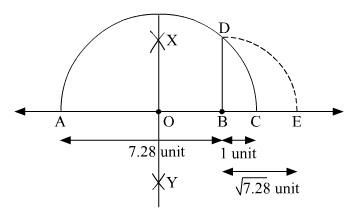
To represent on the number line, follow the following steps of construction:
(i) Mark two points A and B on a given line such that AB = 7.28 units.
(ii) From B, mark a point C on the same given line such that BC = 1 unit.
(iii) Find the mid point of AC and mark it as O.
(iv) With O as centre and radius OC, draw a semi-circle touching the given line at points A and C.
(v) At point B, draw a line perpendicular to AC intersecting the semi-circle at point D.
(vi) With B as centre and radius BD, draw an arc intersecting the given line at point E.
Thus, let us treat the given line as the number line, with B as 0, C as 1, and so on, then point E represents .
Justification:
Here, in semi-circle, radii OA = OC = OD =
And, OB = AB AO = 7.28 4.14 = 3.14 units
In a right angled triangle OBD,
Question 8:
Represent on the number line.
Answer:
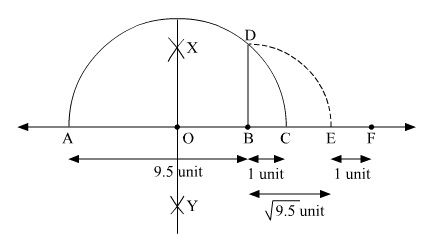
To represent on the number line, follow the following steps of construction:
(i) Mark two points A and B on a given line such that AB = 9.5 units.
(ii) From B, mark a point C on the same given line such that BC = 1 unit.
(iii) Find the mid point of AC and mark it as O.
(iv) With O as centre and radius OC, draw a semi-circle touching the given line at points A and C.
(v) At point B, draw a line perpendicular to AC intersecting the semi-circle at point D.
(vi) With B as centre and radius BD, draw an arc intersecting the given line at point E.
(vii) From E, mark a point F on the same given line such that EF = 1 unit.
Thus, let us treat the given line as the number line, with B as 0, C as 1, E as and so on, then point F represents .
Justification:
Here, in semi-circle, radii OA = OC = OD =
And, OB = AB AO = 9.5 5.25 = 4.25 units
In a right angled triangle OBD,
Question 9:
Visualize the representation of 3.765 on the number line using successive magnification.
Answer:
3 < 3.765 < 4
Divide the gap between 3 and 4 on the number line into 10 equal parts.
Now, 3.7 < 3.765 < 3.8
In order to locate the point 3.765 on the number line, divide the gap between 3.7 and 3.8 into 10 equal parts.
Further, 3.76 < 3.765 < 3.77
So, to locate the point 3.765 on the number line, again divide the gap between 3.76 and 3.77 into 10 equal parts.
Now, the number 3.765 can be located on the number line. This can be shown as follows:
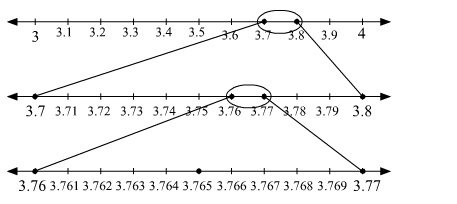
Here, the marked point represents the point 3.765 on the number line.
Question 10:
Visualize the representation of on the number line up to 4 decimal places.
Answer:
(Upto 4 decimal places)
4 < 4.6767 < 5
Divide the gap between 4 and 5 on the number line into 10 equal parts.
Now, 4.6 < 4.6767 < 4.7
In order to locate the point 4.6767 on the number line, divide the gap between 4.6 and 4.7 into 10 equal parts.
Further, 4.67 < 4.6767 < 4.68
To locate the point 4.6767 on the number line, again divide the gap between 4.67 and 4.68 into 10 equal parts.
Again, 4.676 < 4.6767 < 4.677
To locate the point 4.6767 on the number line, again divide the gap between 4.676 and 4.677 into 10 equal parts.
Now, the number 4.6767 can be located on the number line. This can be shown as follows:
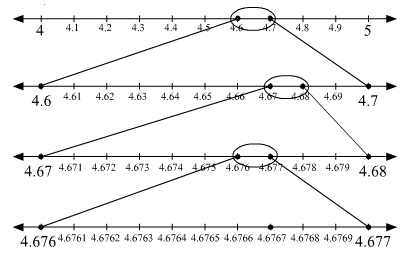
Here, the marked point represents the point on the number line up to 4 decimal places.
Page No 43: Ex. 1F
Question 1:
Write the rationalising factor of the denominator in .
Answer:
Here, the denominator i.e. 1 is a rational number. Thus, the rationalising factor of the denominator in is .
Question 2:
Rationalise the denominator of each of the following.
(i) (ii) (iii)
(iv) (v) (vi)
(vii) (viii) (ix)
Answer:
(i)
On multiplying the numerator and denominator of the given number by , we get:
(ii)
On multiplying the numerator and denominator of the given number by , we get:
(iii)
On multiplying the numerator and denominator of the given number by , we get:
(iv)
On multiplying the numerator and denominator of the given number by , we get:
(v)
On multiplying the numerator and denominator of the given number by , we get:
(vi)
Multiplying the numerator and denominator by , we get
(vii)
Multiplying the numerator and denominator by , we get
(viii)
Multiplying the numerator and denominator by , we get
(ix)
Multiplying the numerator and denominator by , we get
Question 3:
It being given that , find the value of three places of decimals, of each of the following.
(i)
(ii)
(iii)
Answer:
(i)
(ii)
(iii)
Question 4:
Find rational numbers a and b such that
(i)
(ii)
(iii)
(iv)
Answer:
(i)
(ii)
(iii)
(iv)
Question 5:
It being given that , find to three places of decimal, the value of each of the following.
(i)
(ii)
(iii)
(iv)
(v)
(vi)
Answer:
(i)
(ii)
(iii)
(iv)
(v)
(vi)
Question 6:
Simplify by rationalising the denominator.
(i)
(ii)
Answer:
(i)
(ii)
Question 7:
Simplify
(i)
(ii)
(iii)
(iv)
Answer:
(i)
(ii)
(iii)
(iv)
Question 8:
Prove that
(i)
(ii)
Answer:
(i)
(ii)
Question 9:
Find the values of a and b if
Answer:
Comparing with the given expression, we get
a = 0 and b = 1
Thus, the values of a and b are 0 and 1, respectively.
Question 10:
Simplify .
Answer:
Question 11:
If , check whether is rational or irrational.
Answer:
Adding (1) and (2), we get
, which is a rational number
Thus, is rational.
Question 12:
If , find value of .
Answer:
Subtracting (2) from (1), we get
Thus, the value of is .
Question 13:
If , find the value of .
Answer:
Adding (1) and (2), we get
Squaring on both sides, we get
Thus, the value of is 322.
Question 14:
If , find the value of .
Answer:
Adding (1) and (2), we get
Thus, the value of is 5.
Question 15:
If , find the value of .
Answer:
Subtracting (2) from (1), we get
Thus, the value of is .
Question 16:
If , find the value of .
Answer:
Subtracting (2) from (1), we get
Thus, the value of is .
Question 17:
If , find the value of .
Answer:
Adding (1) and (2), we get
Cubing both sides, we get
[Using (3)]
Thus, the value of is 52.
Question 18:
If , show that .
Answer:
Disclaimer: The question is incorrect.
The question is incorrect. Kindly check the question.
The question should have been to show that .
Question 19:
If , show that .
Answer:
According to question,
Now,
Hence, .
Question 20:
If , find the value of a2 + b2 – 5ab.
Answer:
According to question,
Now,
Hence, the value of a2 + b2 – 5ab is 93.
Question 21:
If , find the value of p2 + q2.
Answer:
According to question,
Now,
Hence, the value of p2 + q2 is 47.
Question 22:
Rationalise the denominator of each of the following.
(i) (ii) (iii)
Answer:
Hence, the rationalised form is .
Hence, the rationalised form is .
Hence, the rationalised form is .
Question 23:
Given, , find the value of correct to 3 places of decimal.
Answer:
Hence, the value of correct to 3 places of decimal is −1.465.
Question 24:
If , find the value of x3 – 2x2 – 7x + 5.
Answer:
Now,
Hence, the value of x3 – 2x2 – 7x + 5 is 3.
Question 25:
Evaluate , it being given that .
Hint
Answer:
Hence, = 5.398 .
Page No 53: Ex. 1G
Question 1:
Simplify
(i)
(ii)
(iii)
(iv)
Answer:
(i)
(ii)
(iii)
(iv)
Question 2:
Simplify:
(i)
(ii)
(iii)
Answer:
Question 3:
Simplify:
(i)
(ii)
(iii)
Answer:
Question 4:
Simplify:
(i) (34)1/4
(ii) (31/3)4
(iii)
Answer:
Question 5:
Evaluate
(i)
(ii)
(iii)
(iv)
(v)
(vi)
Answer:
Question 6:
If a = 2, b = 3, find the values of
(i) (ab + ba)–1
(ii) (aa + bb)–1
Answer:
(i) (ab + ba)–1
(ii) (aa + bb)–1
Question 7:
Simplify
(i)
(ii) (14641)0.25
(iii)
(iv)
Answer:
(i)
(ii) (14641)0.25
(iii)
(iv)
Question 8:
Evaluate
(i)
(ii)
(iii)
(iv)
Answer:
(i)
(ii)
(iii)
(iv)
Question 9:
Evaluate
(i)
(ii)
(iii)
(iv)
Answer:
(i)
(ii)
(iii)
(iv)
Question 10:
Prove that
(i)
(ii)
(iii)
Answer:
(i)
(ii)
(iii)
Question 11:
Simplify and express the result in the exponential form of x.
Answer:
Hence, the result in the exponential form is .
Question 12:
Simplify the product .
Answer:
Question 13:
Simplify
(i)
(ii)
(iii)
Answer:
(i)
(ii)
(iii)
Question 14:
Find the value of x in each of the following.
(i)
(ii)
(iii)
(iv)
(v)
Answer:
Hence, the value of x is 6.
Hence, the value of x is 22.
Hence, the value of x is 5.
Hence, the value of x is 5.
Hence, the value of x is .
Question 15:
Prove that
(i) .
(ii)
(iii)
(iv)
Answer:
(i)
Hence, .
(ii)
Hence, .
(iii)
Hence, .
(iv)
Hence, .
Question 16:
If x is a positive real number and exponents are rational numbers, simplify
Answer:
Question 17:
If , prove that m – n = 1.
Answer:
Hence, m – n = 1.
Question 18:
Write the following in ascending order of magnitude.
.
Answer:
Page No 57: MULTIPLE CHOICE QUESTIONS (MCQ)
Question 1:
Which of the following is a rational number?
(a)
(b) π
(c)
(d) 0
Answer:
Since, the sum and product of a rational and an irrational is always irrational.
So, and are irrational numbers.
Also, π is an irrational number.
And, 0 is an integer.
So, 0 is a rational number.
Hence, the correct option is (d).
Question 2:
A rational number between –3 and 3 is
(a) 0
(b) –4.3
(c) –3.4
(d) 1.101100110001...
Answer:
Since, –4.3 < –3.4 < –3 < 0 < 1.101100110001... < 3
But 1.101100110001... is an irrational number
So, the rational number between –3 and 3 is 0.
Hence, the correct option is (a).
Question 3:
Two rational numbers between are
(a)
(b)
(c)
(d)
Answer:
We have,
And,
Also,
Since,
So, the two rational numbers between are .
Hence, the correct opion is (c).
Question 4:
Every point on a number line represents
(a) a rational number
(b) a natural number
(c) an irrational number
(d) a unique number
Answer:
As, all rational numbers, all natural numbers and all irrational numbers can be represented on a nuumber line in an unique way.
So, every point on a number line represents a unique number.
Hence, the correct option is (d).
Question 5:
Which of the following is a rational number?
(a)
(b)
(c)
(d) 0.1010010001....
Answer:
(c)
Because 225 is a square of 15, i.e., = 15, and it can be expressed in the form, it is a rational number.
Question 6:
Every rational number is
(a) a natural number
(b) a whole number
(c) an integer
(d) a real number
Answer:
(d) a real number
Every rational number is a real number, as every rational number can be easily expressed on the real number line.
Question 7:
Between any two rational numbers there
(a) is no rational number
(b) is exactly one rational numbers
(c) are infinitely many rational numbers
(d) is no irrational number
Answer:
(c) are infinitely many rational numbers
Because the range between any two rational numbers can be easily divided into any number of divisions, there can be an infinite number of rational numbers between any two rational numbers.
Question 8:
The decimal representation of a rational number is
(a) always terminating
(b) either terminating or repeating
(c) either terminating or non-repeating
(d) neither terminating nor repeating
Answer:
(b) either terminating or repeating
As per the definition of rational numbers, they are either repeating or terminating decimals.
Question 9:
The decimal representation of an irrational number is
(a) always terminating
(b) either terminating or repeating
(c) either terminating or non-repeating
(d) neither terminating nor repeating
Answer:
(d) neither terminating nor repeating
As per the definition of irrational numbers, these are neither terminating nor repeating decimals.
Question 10:
The decimal expansion that a rational number cannot have is
(a) 0.25
(b)
(c)
(d) 0.5030030003...
Answer:
As, any number which have a terminating or non-terminating recurring decimal expansion is a rational number.
So, 0.5030030003... which is non-termintaing non-recurring decimal expansion is not a rational number.
Hence, the correct option is (d).
Question 11:
Which of the following is an irrational number?
(a) 3.14
(b) 3.141414...
(c) 3.14444...
(d) 3.141141114...
Answer:
(d) 3.141141114...
Because 3.141141114... is neither a repeating decimal nor a terminating decimal, it is an irrational number.
Question 12:
A rational number equivalent to is
(a)
(b)
(c)
(d)
Answer:
Since,
Hence, the correct option is (d).
Question 13:
Choose the rational number which does not lie between .
(a)
(b)
(c)
(d)
Answer:
We have,
And,
Since,
So, the rational number which does not lie between is .
Hence, the correct option is (b).
Question 14:
π is
(a) a rational number
(b) an integer
(c) an irrational number
(d) a whole number
Answer:
Since, π has a non-terminating non-recurring decimal expansion.
So, π is an irrational number.
Hence, the correct option is (c).
Question 15:
Decimal expansion of is
(a) a finite decimal
(b) 1.4121
(c) non-terminating recurring
(d) non-terminating, non-recurring
Answer:
(c) a non-terminating and non-repeating decimal
Because is an irrational number, its decimal expansion is non-terminating and non-repeating.
Question 16:
Which of the following is an irrational number?
(a)
(b)
(c) 0.3799
(d)
Answer:
Since, = 15, which is an integer,
0.3799 is a number with terminating decimal expansion, and
is a number with non-terminating recurring decimal expansion
Also, 23 is a prime number.
So, is an irrational number.
Hence, the correct option is (a).
Question 17:
How many digits are there in the repeating block of digits in the decimal expansion of ?
(a) 16
(b) 6
(c) 26
(d) 7
Answer:
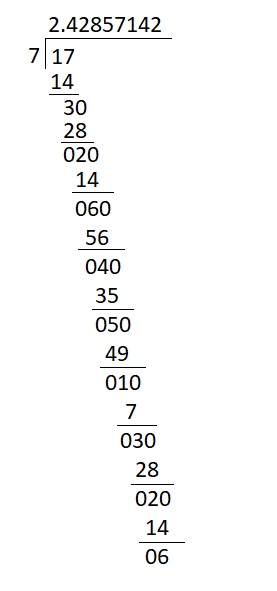
So, there are 6 digits in the repeating block of digits in the decimal expansion of .
Hence, the correct option is (b).
Question 18:
Which of the following numbers is irrational?
(a)
(b)
(c)
(d)
Answer:
Since,
, which is a rational number,
, which is a rational number,
, which is an irrational number, and
, which is a rational number
Hence, the correct option is (c).
Question 19:
The product of two irrational number is
(a) always irrational
(b) always rational
(c) always an integer
(d) sometimes rational and sometimes irrational
Answer:
(d) sometimes rational and sometimes irrational
For example:
is an irrational number, when it is multiplied with itself it results into 2, which is a rational number.
when multiplied with , which is also an irrational number, results into , which is an irrational number.
Question 20:
Which of the following is a true statment?
(a) The sum of two irrational numbers is an irrational number
(b) The product of two irrational numbers is an irrational number
(c) Every real number is always rational
(d) Every real number is either rational or irrational
Answer:
(d) Every real number is either rational or irrational.
Because a real number can be further categorised into either a rational number or an irrational number, every real number is either rational or irrational.
Question 21:
Which of the following is a true statment?
(a) are both rationals
(b) are both irrationals
(c) is rational and is irrational
(d) is irrational and is rational
Answer:
(d) is irrational and is rational.
Because the value of is neither repeating nor terminating, it is an irrational number. , on the other hand, is of the form , so it is a rational number.
Question 22:
A rational number lying between is
(a)
(b)
(c) 1.6
(d) 1.9
Answer:
Since, and are irrational numbers,
And,
So, the rational number lying between is 1.6 .
Hence, the correct option is (c).
Question 23:
Which of the following is a rational number?
(a)
(b) 0.101001000100001...
(c) π
(d) 0.853853853...
Answer:
Since, a number whose decimal expansion is terminating or non-terminating recurring is rational number.
So, 0.853853853... is a rational number.
Hence, the correct option is (d).
Question 24:
The product of a nonzero rational number with an irrational number is always a/an
(a) irrational number
(b) rational number
(c) whole number
(d) natural number
Answer:
Since, the product of a non-zero rational number with an irrational number is always an irrational number.
Hence, the correct option is (a).
Question 25:
The value of in the form , where p and q are integers and q ≠ 0, is
(a)
(b)
(c)
(d)
Answer:
Let
Multiplying both sides by 10, we get
Subtracting (1) from (2), we get
Hence, the correct answer is option (b).
Question 26:
The simplest for of is
(a)
(b)
(c)
(d) none of these
Answer:
(c)
Let x = 1.6666666... ...(i)
Multiplying by 10 on both sides, we get:
10x = 16.6666666... ...(ii)
Subtracting (i) from (ii), we get:
9x = 15
x =
Question 27:
The simplest form of is
(a)
(b)
(c)
(d) none of these
Answer:
(b)
Let x = 0.545454... ...(i)
Multiplying both sides by 100, we get:
100x = 54.5454545... ...(ii)
Subtracting (i) from (ii), we get:
99x = 540
x = =
Question 28:
The simplest form of is
(a)
(b)
(c)
(d) none of these
Answer:
(c)
Let x = 0.3222222222... ...(i)
Multiplying by 10 on both sides, we get:
10x = 3.222222222... ...(ii)
Again, multiplying by 10 on both sides, we get:
100x = 32.222222222... ...(iii)
On subtracting (ii) from (iii), we get:
90x = 29
∴ x =
Question 29:
The simplest form of is
(a)
(b)
(c)
(d) none of these
Answer:
(d) none of these
Let x = 0.12333333333... ...(i)
Multiplying by 100 on both sides, we get:
100x = 12.33333333... ...(ii)
Multiplying by 10 on both sides, we get:
1000x = 123.33333333... ...(iii)
Subtracting (ii) from (iii), we get:
900x = 111
x =
Question 30:
An irrational number between 5 and 6 is
(a)
(b)
(c)
(d) none of these
Answer:
(c)
An irrational number between a and b is given as .
Question 31:
An irrational number between is
(a)
(b)
(c) 51/4
(d) 61/4
Answer:
(d) 61/4
An irrational number between
Question 32:
An irrational number between is
(a)
(b)
(c)
(d) none of these
Answer:
(c)
An irrational number between a and b is given as .
Question 33:
The sum of is
(a)
(b)
(c)
(d)
Answer:
Let
Multiplying both sides by 10, we get
Subtracting (1) from (2), we get
Let
Multiplying both sides by 10, we get
Subtracting (3) from (4), we get
Sum of and =
Hence, the correct answer is option (b).
Question 34:
The value of is
(a)
(b)
(c)
(d)
Answer:
Let
Multiplying both sides by 100, we get
Subtracting (1) from (2), we get
Let
Multiplying both sides by 100, we get
Subtracting (3) from (4), we get
So,
Hence, the correct answer is option (c).
Question 35:
Which of the following is the value of ?
(a) –4
(b) 4
(c)
(d)
Answer:
Hence, the correct answer is option (b).
Question 36:
when simplified is
(a) positive and irrational
(b) positive and rational
(c) negative and irrational
(d) negative and rational
Answer:
Thus, the given expression when simplified is positive and rational.
Hence, the correct answer is option (b).
Question 37:
when simplified is
(a) positive and irrational
(b) positive and rational
(c) negative and irrational
(d) negative and rational
Answer:
Thus, the given expression when simplified is positive and rational.
Hence, the correct answer is option (b).
Question 38:
When is divided by , the quotient is
(a)
(b)
(c)
(d)
Answer:
Hence, the correct answer is option (c).
Question 39:
The value of is
(a) 10
(b)
(c)
(d)
Answer:
Hence, the correct answer is option (a).
Question 40:
The value of is
(a)
(b)
(c)
(d)
Answer:
Hence, the correct answer is option (b).
Question 41:
(i)
(ii)
(iii)
(iv) None of these
Answer:
Hence, the correct answer is option (ii).
Question 42:
(a)
(b) 2
(c) 4
(d) 8
Answer:
Hence, the correct answer is option (b).
Question 43:
(125)–1/3 = ?
(a) 5
(b) –5
(c)
(d)
Answer:
Hence, the correct answer is option (c).
Question 44:
The value of is
(a) (28)1/2
(b) (56)1/2
(c) (14)1/2
(d) (42)1/2
Answer:
Hence, the correct answer is option (b).
Question 45:
After simplification, is
(a)
(b)
(c)
(d)
Answer:
Hence, the correct answer is option (d).
Question 46:
The value of is
(a)
(b)
(c) 8
(d)
Answer:
The value of is .
Hence, the correct option is (a).
Question 47:
The value of is
(a) 0
(b) 2
(c)
(d)
Answer:
The value of is 2.
Hence, the correct option is (b).
Question 48:
The value of is
(a) 3
(b) –3
(c) 5
(d)
Answer:
The value of is 3.
Hence, the correct option is (a).
Question 49:
= ?
(a) 432
(b) 270
(c) 486
(d) 540
Answer:
Hence, the correct option is (c).
Question 50:
Simplified value of is
(a) 0
(b) 1
(c) 4
(d) 16
Answer:
Simplified value of is 1.
Hence, the correct option is (b).
Question 51:
The value of is
(a)
(b)
(c)
(d)
Answer:
The value of is .
Hence, the correct option is (c).
Question 52:
Simplified value of is
(a) 25
(b) 3
(c) 1
(d) 5
Answer:
Simplified value of is 5.
Hence, the correct option is (d).
Question 53:
The value of is
(a) 3
(b) –3
(c) 9
(d)
Answer:
The value of is 3.
Hence, the correct option is (a).
Question 54:
There is a number x such that x2 is irrational but x4 is rational. Then, x can be
(a)
(b)
(c)
(d)
Answer:
x can be .
Hence, the correct option is (d).
Question 55:
If then the value of p is
(a)
(b)
(c)
(d)
Answer:
Hence, the correct option is (b).
Question 56:
The value of is
(a)
(b)
(c)
(d)
Answer:
Hence, the correct option is (b).
Question 57:
The value of is equal to
(a) 0
(b) 1
(c) x
(d) xpqr
Answer:
Hence, the correct option is (b).
Question 58:
The value of is
(a) –1
(b) 0
(c) 1
(d) 2
Answer:
Hence, the correct option is (c).
Question 59:
(a) 2
(b)
(c)
(d)
Answer:
Hence, the correct option is (a).
Question 60:
If
(a) 1
(b) 2
(c) 3
(d) 4
Answer:
Hence, the correct answer is option (d).
Question 61:
If
(a) 1
(b) 5
(c) 25
(d) 125
Answer:
Hence, the correct answer is option (d).
Question 62:
On simplification, the expression equals
(a)
(b)
(c)
(d)
Answer:
Hence, the correct answer is option (b).
Question 63:
The simplest rationalisation factor of is
(a)
(b)
(c)
(d)
Answer:
So, the simplest rationalisation factor of is .
Hence, the correct answer is option (d).
Question 64:
The simplest rationalisation ractor of is
(a)
(b)
(c)
(d)
Answer:
Simplest rationalisation ractor of is .
Hence, the correct answer is option (b).
Question 65:
The rationalisation factor of is
(a)
(b)
(c)
(d)
Answer:
Rationalisation factor of will be .
Hence, the correct answer is option (d).
Question 66:
Rationalisation of the denominator of gives
(a)
(b)
(c)
(d)
Answer:
Rationalisation of denominator gives
Hence, the correct answer is option (d).
Question 67:
If equals
(a)
(b) 2
(c) 4
(d)
Answer:
Hence, the correct answer is option (c).
Question 68:
(a)
(b)
(c)
(d) None of these
Answer:
Hence, the correct answer is option (c).
Question 69:
If
(a)
(b) 14
(c) 49
(d) 48
Answer:
Given:
Hence, the correct answer is option (b).
Question 70:
If
(a) 0.075
(b) 0.75
(c) 0.705
(d) 7.05
Answer:
Hence, the correct answer is option (c).
Question 71:
If =?
(a) 0.375
(b) 0.378
(c) 0.441
(d) None of these
Answer:
Given that
Hence, the correct answer is option (b).
Question 72:
The value of is
(a)
(b)
(c)
(d)
Answer:
This is of the form
Hence, the correct answer is option (d).
Question 73:
The value of is
(a)
(b)
(c)
(d)
Answer:
This is in the form
So, we have
Thus,
Hence, the correct answer is option (c).
Question 74:
If
(a) 0.207
(b) 2.414
(c) 0.414
(d) 0.621
Answer:
Hence, the correct answer is option (c).
Question 75:
If
(a) 34
(b) 56
(c) 28
(d) 63
Answer:
Given:
Hence, the correct answer is option (a).
Question 76:
Assertion: Three rational numbers between .
Reason: A rational number between two rational numbers p and q is .
(a) Both Assertion and Reason are true and Reasom is a correct explanation of Assertion.
(b) Both Assertion and Reason and Reasom are true but Reasom is not a correct explanation of Assertion.
(c) Assertion is true and Reasom is false.
(d) Assertion is false and Reasom is true.
Answer:
(a) Both Assertion and Reason are true, and Reason is the correct explanation of Assertion.
So, Assertion and Reason are correct (property of rational numbers). Also, Reason is the correct explanation of Assertion.
Question 77:
Assertion: is an irrational number.
Reason: Square root a positive integer which is not a perfect square is an irrational number.
(a) Both Assertion and Reason are true and Reasom is a correct explanation of Assertion.
(b) Both Assertion and Reason and Reasom are true but Reasom is not a correct explanation of Assertion.
(c) Assertion is true and Reasom is false.
(d) Assertion is false and Reasom is true.
Answer:
(a) Both Assertion and Reason are true, and Reason is the correct explanation of Assertion.
Question 78:
Assertion: e is irrational number.
Reason: is an irrational number.
(a) Both Assertion and Reason are true and Reasom is a correct explanation of Assertion.
(b) Both Assertion and Reason and Reasom are true but Reasom is not a correct explanation of Assertion.
(c) Assertion is true and Reasom is false.
(d) Assertion is false and Reasom is true.
Answer:
(b) Both Assertion and Reason are true, but Reason is not a correct explanation of Assertion.
It is known that e and are irrational numbers, but Reason is not the correct explanation.
Question 79:
Assertion: is an irrational number.
Reason: The sum of rational number and an irrational number is an irrational number.
(a) Both Assertion and Reason are true and Reasom is a correct explanation of Assertion.
(b) Both Assertion and Reason and Reasom are true but Reasom is not a correct explanation of Assertion.
(c) Assertion is true and Reasom is false.
(d) Assertion is false and Reasom is true.
Answer:
(b) Both Assertion and Reason are true, but Reason is not a correct explanation of Assertion.
Question 80:
Match the following columns:
| Column I | Column II | ||
| (a) | is ....... . | (p) | 14 |
| (b) | is ...... . | (q) | 6 |
| (c) | The length of period of =...... . | (r) | a rational number |
| (d) | If , then ....... . | (s) | an irrational number |
(b) ........
(c) ........
(d) ........
Answer:
(a) Because it is a non-terminating and repeating decimal, it is a rational number.
(b) is an irrational number.
(c) ...
Hence, its period is 6.
(d)
Question 81:
Match the following columns:
| Column I | Column II | ||
| (a) | (p) | 4 | |
| (b) | If , then x = ........ . | (q) | |
| (c) | If , then = ...... . | (r) | |
| (d) | (s) | 3 | |
(a) ......
(b) ......
(c) ......
(d) ......
Answer:
(a)
(b)
(c)
(d)
Page No 65:Test Yourself
Question 1:
What can you say about the sum of a rational number and an irrational number?
Answer:
Sum of a rational number and an irrational number is an irrational number.
Example: 4 + represents sum of rational and an irrational number where 4 is rational and is irrational.
Question 2:
Solve .
Answer:
Question 3:
The number will terminate after how many decimal places?
Answer:
So, will terminate after 3 decimal places.
Question 4:
Find the value of .
Answer:
Question 5:
Simplify .
Answer:
Question 6:
Find an irrational number between 5 and 6.
Answer:
A number which is non terminating and non recurring is known as irrational number.
There are infinitely many irrational numbers between 5 and 6.
One of the example is 5.40430045000460000....
Question 7:
Find the value of .
Answer:
Hence, the value of is .
Question 8:
Rationalise .
Answer:
Hence, the rationalised form is .
Question 9:
Solve for x: .
Answer:
Hence, .
Question 10:
Simplify .
Answer:
Hence, = 11.
Question 11:
Evaluate .
Answer:
Hence, .
Question 12:
Simplify .
Answer:
Question 13:
If a = 1, b = 2 then find the value of (ab + ba)–1.
Answer:
For a = 1and b = 2,
Thus, the value of (ab + ba)–1 when a = 1 and b = 2 is .
Question 14:
Simplify .
Answer:
Question 15:
Give an example of two irrational numbers whose sum as well as product is rational.
Answer:
Let the two irrational numbers be and .
Sum of these irrational numbers , which is rational
Product of these irrational numbers , which is rational
Question 16:
Is the product of a rational and an irrational number always irrational? Give an example.
Answer:
Yes, the product of a rational and an irrational number is always an irrational number.
Example:
2 is a rational number and is an irrational number.
Now, , which is an irrational number.
Question 17:
Give an example of a number x such that x2 is an irrational number and x3 is a rational number.
Answer:
The cube roots of natural numbers which are not perfect cubes are all irrational numbers.
Let .
Now,
, which is an irrational number
Also,
, which is a rational number
Question 18:
Write the reciprocal of .
Answer:
The reciprocal of
Question 19:
If , find the value of .
Answer:
The value of
Question 20:
Simplify .
Answer:
Question 21:
If 10x = 64, find the value of .
Answer:
We have,
Taking square root from both sides, we get
Multiplying both sides by 10, we get
Question 22:
Evaluate .
Answer:
Question 23:
Simplify .